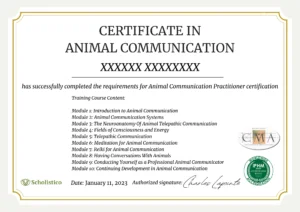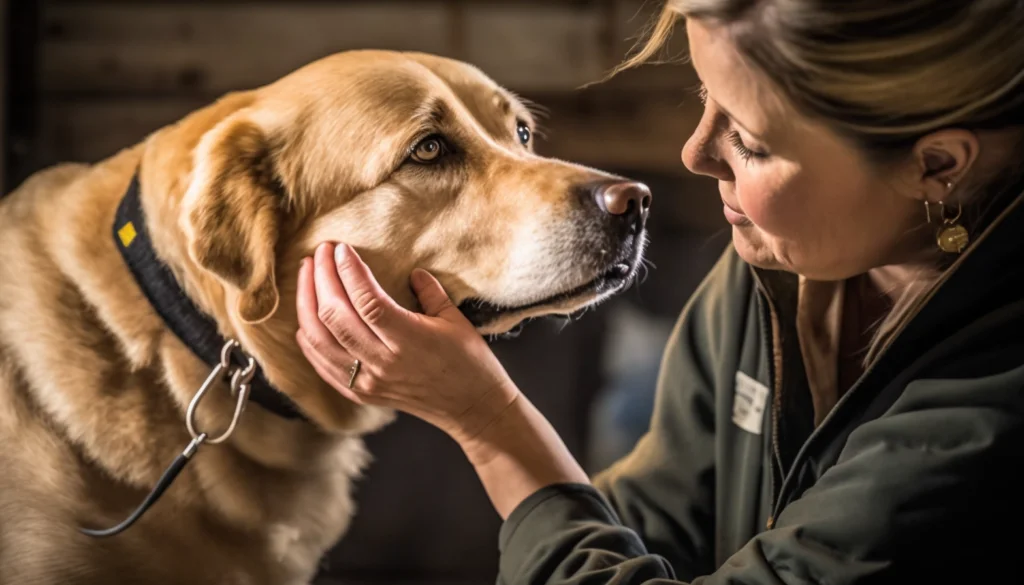Animal Communication Course: Learn to Communicate

At Scholistico, we understand the importance of animal communication, and we offer an online course that allows students to learn this valuable skill from the comfort of their own homes. In this article, we’ll explore the topic of animal communication, including what it is, why it’s important, and how our course can help you master this valuable skill.
Understanding Animal Language
Animals communicate with each other in a variety of ways, using both verbal and nonverbal cues. Some animals, such as birds and whales, use complex songs and calls to communicate with others of their species. Other animals, such as dogs, use body language to communicate with their owners and other animals.
It’s important to understand animal language because it can help you communicate better with your pets and other animals. By understanding the signals that animals use to communicate, you can better interpret their needs and emotions.
Types of Animal Communication
There are four main types of animal communication: verbal, nonverbal, telepathic, and chemical.
Verbal Communication
This type of communication involves the use of sound to convey messages. Animals can produce a wide range of sounds, such as vocalizations, growls, grunts, and chirps, which can be used for different purposes, such as warning of danger, establishing territories, or attracting mates.
Non-Verbal Communication
Non-verbal communication involves the use of body language, facial expressions, and gestures to convey messages. It’s especially important for social animals, such as primates, elephants, and dogs. Non-verbal communication can be used to show dominance, submission, or aggression, or to establish social bonds.
Telepathic Communication
Telepathic communication refers to the transfer of information between individuals without the use of sensory channels or physical contact. It’s often associated with psychic abilities, such as the ability to communicate with animals or read their minds. While the scientific evidence for telepathic communication is still limited, some animal behavior experts believe that animals may use telepathy to communicate with each other or with humans.
Chemical Communication
Chemical communication involves the use of scents or chemical signals to convey messages. Many animals, such as dogs, use scent marking to establish territories or communicate with other members of their species. Chemical communication can also be used to signal danger or attract mates.
Understanding these different types of communication can help you better communicate with animals, whether you’re a pet owner, animal trainer, or simply someone who loves animals.
Communication with Dogs
Dogs are one of the most popular pets, and it’s important to understand their unique form of communication. Dogs use body language to communicate with their owners and other animals, including the position of their ears, the position of their tail, and the way they move their bodies.
Our course includes a section on dog communication, which covers topics such as dog body language, dog ear body language, and dog communication buttons. We’ll teach you how to effectively communicate with your dog, which can help strengthen the bond between you and your furry friend.
Spiritual Connection with Animals
Many people believe in the spiritual connection between humans and animals. Our course includes a section on how to connect with animals spiritually, which covers topics such as finding your spirit animal and the five animal spirits and their meanings.
Whether you believe in the spiritual connection between humans and animals or not, it’s clear that animals have a unique ability to connect with humans on a deep level. By learning how to communicate with animals, you can strengthen your bond with your pets and other animals in your life.
Scholistico’s Animal Communication Course
Our animal communication course is designed to help you master the art of animal communication. The course includes a comprehensive syllabus, which covers topics such as animal language, types of animal communication, communication with dogs, and spiritual connection with animals.
Our course is internationally certified, which means that you can take it from anywhere in the world. We offer flexible study options, which means that you can study from home, whenever you want, and without time restrictions. Our course also includes testimonials from students who have successfully completed the course, and have seen real results in their ability to communicate with animals.
FAQ Section
Here are some frequently asked questions about animal communication and our course:
What is animal communication?
Animal communication is the transfer of information between animals using signals such as sounds, body language, pheromones, and chemical signals. It can involve communication between members of the same species or between different species.
How do you communicate with animals?
Communicating with animals involves observing their behavior and understanding their language. It can involve listening to their sounds, watching their body language, and responding appropriately. Developing a spiritual connection with animals can also enhance communication.
What are the benefits of learning animal communication?
Learning animal communication can help you understand your pets better, improve your relationships with animals, and increase your ability to provide care and comfort to them. It can also enhance your overall sense of well-being and connectedness with nature.
How long does it take to learn animal communication?
The length of time it takes to learn animal communication can vary depending on the individual and the method of learning. Some people may see improvement in their ability to communicate with animals after just a few sessions, while others may need to devote more time to training and practice.
What are the requirements for taking Scholistico’s animal communication course?
Scholistico’s animal communication course is open to anyone who has an interest in learning how to communicate with animals. No prior experience or training is required. All you need is a willingness to learn and a desire to connect with animals on a deeper level.
In conclusion, animal communication is a valuable skill that can help you better understand your pets and other animals. At Scholistico, we offer an online course that allows you to learn this skill from anywhere in the world. Our course covers a range of topics, including animal language, types of animal communication, communication with dogs.
Certification and Continuing Education
Becoming a certified animal communicator can provide many benefits, including increased credibility and enhanced marketability. The International Practitioners of Holistic Medicine (IPHM) and the Complementary Medical Association (CMA) are two well-respected organizations that offer certification for animal communication.
IPHM is an independent accrediting board that provides accreditation to holistic health practitioners, including animal communicators, who meet their rigorous standards. CMA is a non-profit organization that supports complementary medicine practitioners through education, research, and advocacy. Both organizations offer certification programs that require extensive study and training in animal communication.
Earning a certification from IPHM or CMA can demonstrate to potential clients and employers that you are committed to professional excellence in animal communication. It can also provide opportunities for continuing education and professional development. Many animal communication practitioners continue to take courses and workshops to improve their skills and stay up-to-date on the latest research and techniques.
In conclusion, if you are interested in animal communication, there are many ways to learn and develop your skills. Taking an online course with Scholistico or another reputable provider can provide a solid foundation in animal language and communication. Additionally, pursuing certification through IPHM or CMA can offer many benefits, including increased credibility and continuing education opportunities. By investing in your education and training, you can open up a world of possibilities for yourself and the animals you communicate with.













Responses